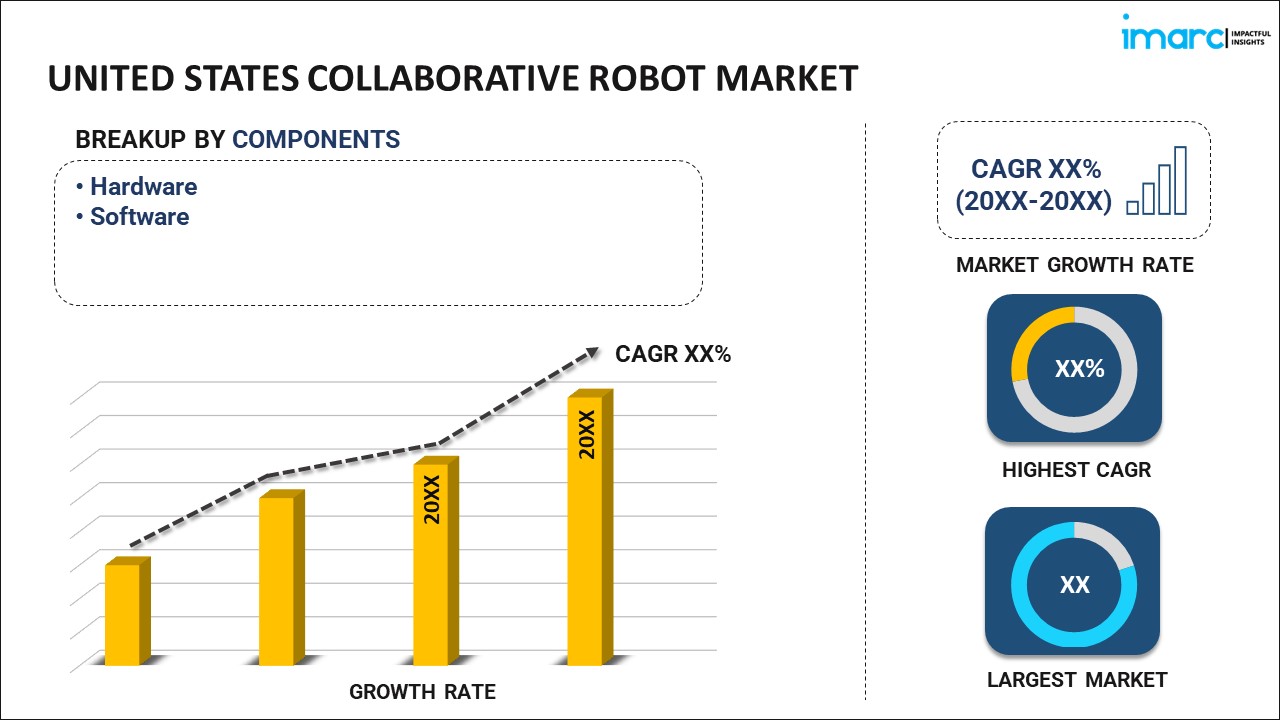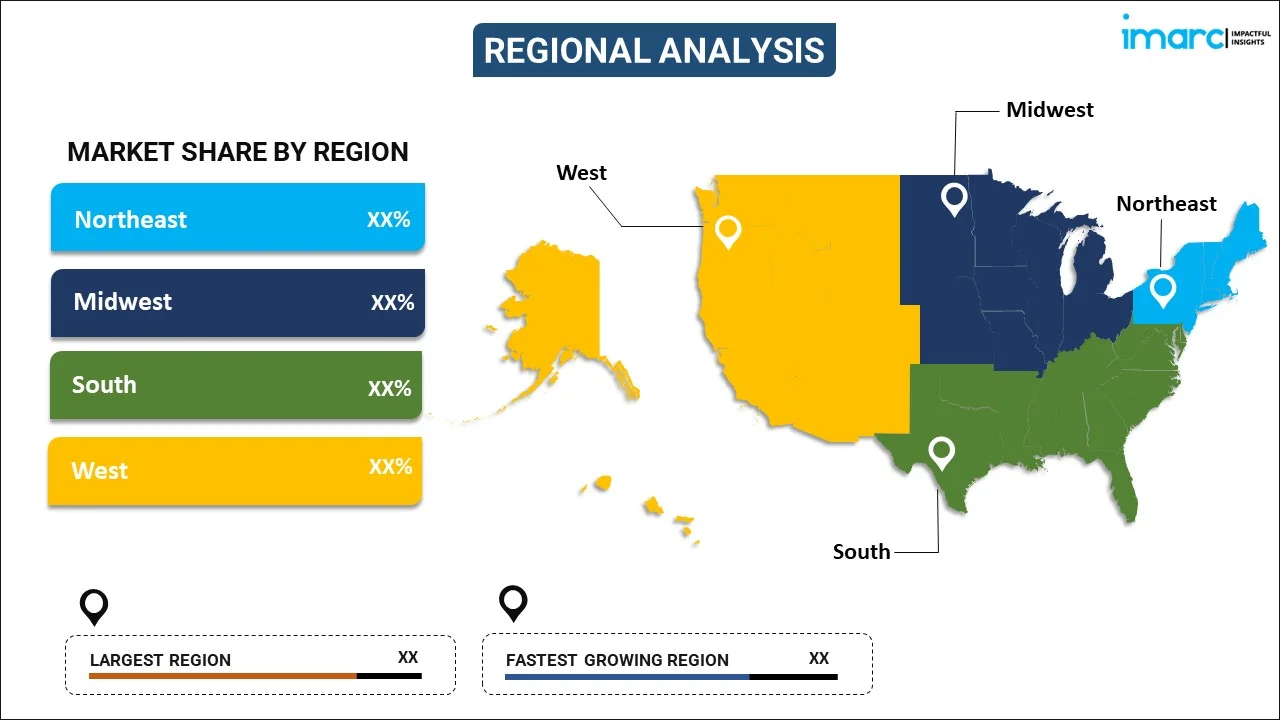
United States Collaborative Robot Market Report by Component (Hardware, Software), Payload (Upto 5 Kg, 5-10 Kg, Above 10 Kg), Application (Material Handling, Pick and Place, Assembly, Palletizing and De-Palletizing, and Others), End Use Industry (Automotive, Electronics, Manufacturing, Food and Beverage, Chemicals and Pharmaceutical, and Others), and Region 2025-2033
Market Overview:
United States collaborative robot market size reached USD 913.2 Million in 2024. Looking forward, IMARC Group expects the market to reach USD 8,723.6 Million by 2033, exhibiting a growth rate (CAGR) of 28.5% during 2025-2033. The ongoing advancements in robotics technology, such as improved sensors, vision systems, and artificial intelligence, which have contributed to the development of more sophisticated and capable collaborative robots, are driving the market.
|
Report Attribute
|
Key Statistics
|
|---|---|
|
Base Year
|
2024 |
|
Forecast Years
|
2025-2033
|
|
Historical Years
|
2019-2024
|
| Market Size in 2024 | USD 913.2 Million |
| Market Forecast in 2033 | USD 8,723.6 Million |
| Market Growth Rate (2025-2033) | 28.5% |
United States Collaborative Robot Market Analysis:
- Major Market Drivers: Growing automation in manufacturing, logistics, and healthcare industries is driving United States collaborative robot market analysis, with huge growth opportunities. Higher labor costs, skills shortages, and requirements for flexible, safe human-robot interaction are driving adoption in small and medium-sized businesses.
- Key Market Trends: Integration of machine learning and AI with collaborative robots is improving safety, adaptability, and precision. Easy-to-use programming interfaces and lightweight, mobile cobots are becoming popular. Increasing use in e-commerce order fulfillment, healthcare support, and electronics manufacturing is designing the collaborative robot market.
- Competitive Landscape: Players are investing in innovation, partnerships, and local growth to enhance their presence. Strategic investments in R&D for multifunctional cobots, modular architecture, and cloud connectivity are fueling United States collaborative robot market demand and confirming the sector's growth potential.
- Challenges and Opportunities: High upfront expenses, security risks, and integration issues are challenges. But the opportunities lie in low-volume manufacturing, medical device automation, and robot intelligence robotics. Growing awareness of productivity savings and safety advantages is likely to drive collaborative robot usage across different applications.
A collaborative robot, or cobot, is a specialized type of robotic system designed to work alongside humans in a shared workspace. Unlike traditional industrial robots, cobots are designed to interact with and assist humans in various tasks without the need for extensive safety measures. They are equipped with advanced sensors and technology that enable them to detect and respond to the presence of humans, ensuring a safe and collaborative working environment. Cobots can be programmed to perform a wide range of tasks, from assembly and packaging to inspection and testing. Their flexibility and adaptability make them well-suited for applications in industries such as manufacturing, healthcare, and logistics, where they enhance efficiency, productivity, and worker safety. The collaborative nature of cobots fosters human-robot teamwork, unlocking new possibilities for automation in diverse work settings.
United States Collaborative Robot Market Trends:
Artificial Intelligence and Machine Learning Integration
The convergence of artificial intelligence (AI) and machine learning (ML) into collaborative robots is revolutionizing automation in industries in the United States. The two technologies make cobots capable of dynamically adapting to changing tasks, improving decision-making processes, and delivering increased accuracy in repetitive and complex tasks. AI-driven analytics also support predictive maintenance, minimizing downtime and operational expenses. The increasing usage of intelligent automation in manufacturing, logistics, and healthcare is driving the growth of United States collaborative robot markets, with efficient workflows and amplified productivity. This shift is also supported by the rising demand for safe human-robot interaction, with AI making real-time adjustments to movements and operational parameters, ensuring workplace safety. As companies continue to invest in intelligent robotics, AI-powered collaborative robots will gain a larger United States collaborative robot market share by promoting technological innovation and operational efficiency in major industrial sectors.
Growth of Flexible and Mobile Cobot Designs
Flexible and mobile collaborative robots are on the rise in the United States as companies look for flexible automation solutions. Portable, lightweight cobots with modular designs enable quick deployment to various workstations, minimizing setup time and maximizing floor space efficiency. The robots are able to execute varied applications, ranging from assembly and packaging to quality inspection, without extensive reprogramming or the need to change infrastructure. The trend dictates flexibility in operations, allowing small and medium businesses to implement automation on an incremental basis while keeping capital spending at a low level. boosted mobility complemented by ease-of-use programming interfaces ensures human operators can interact effortlessly with robots, increasing efficiency and quality output. This accelerating need for flexible robotic solutions is driving steady United States collaborative robot market growth, with flexible models also likely to drive greater market share, indicative of broader adoption in manufacturing and logistics industries.
Cobots Adoption in E-commerce and Healthcare Applications
Increased e-commerce transactions and the need for automated healthcare have spurred the deployment of collaborative robots in the United States. Cobots are gaining traction for order fulfillment, inventory picking, and packaging in warehouses and patient support, rehabilitation, and assisting during surgery in the healthcare industry. Because they can work safely with humans without a lot of safety barriers, they are well-suited for dynamic, high-demand environments. Further, greater sensing capabilities and adaptive task handling enable cobots to deal with multiple workloads effectively, mitigating bottlenecks in operations. The trend is expected to further bolster market growth, as wider usage across logistics and healthcare industries fuels innovation. With increased adoption in these key sectors, collaborative robots are expected to gain a greater United States collaborative robot market share, an indication of their strategic value within the new world of automation.
United States Collaborative Robot Market Segmentation:
IMARC Group provides an analysis of the key trends in each segment of the market, along with forecasts at the country level for 2025-2033. Our report has categorized the market based on component, payload, application, and end use industry.
Component Insights:

To get more information on this market, Request Sample
- Hardware
- Software
The report has provided a detailed breakup and analysis of the market based on the component. This includes hardware and software.
Payload Insights:
- Upto 5 Kg
- 5-10 Kg
- Above 10 Kg
A detailed breakup and analysis of the market based on the payload have also been provided in the report. This includes upto 5 kg, 5-10 kg, and above 10 kg.
Application Insights:
- Material Handling
- Pick and Place
- Assembly
- Palletizing and De-Palletizing
- Others
The report has provided a detailed breakup and analysis of the market based on the application. This includes material handling, pick and place, assembly, palletizing and de-palletizing, and others.
End Use Industry Insights:
- Automotive
- Electronics
- Manufacturing
- Food and Beverage
- Chemicals and Pharmaceutical
- Others
A detailed breakup and analysis of the market based on the end use industry have also been provided in the report. This includes automotive, electronics, manufacturing, food and beverage, chemicals and pharmaceutical, and others.
Regional Insights:

- Northeast
- Midwest
- South
- West
The report has also provided a comprehensive analysis of all the major regional markets, which include Northeast, Midwest, South, and West.
Competitive Landscape:
The market research report has also provided a comprehensive analysis of the competitive landscape. Competitive analysis such as market structure, key player positioning, top winning strategies, competitive dashboard, and company evaluation quadrant has been covered in the report. Also, detailed profiles of all major companies have been provided.
Latest News and Developments:
- In June 2025, Comau officially introduced its new MyCo family of six collaborative robots at Automatica 2025 in Munich, Germany. With payloads ranging from 3 kg to 15 kg, easy-to-use programming, fast redeployment, and cutting-edge safety features, the MyCo cobots offer flexible and dependable automation solutions for various industrial uses.
- In June 2025, Epson is planning to introduce its first collaborative robot solution to the manufacturing, logistics, and life sciences industries. With a 6 kg payload, 900 mm arm, Python support, and cleanroom compatibility, the light, compact cobot is intended to increase efficiency, productivity, and flexible automation in a variety of industrial settings.
- In August 2025, Nvidia introduced the Jetson AGX Thor computing module for humanoid robots providing up to 2,070 FP4 teraflops AI compute with 128GB memory. The module supports on-robot generative AI models, providing improved performance, power efficiency, and real-time capabilities to sophisticated robotics applications across various industries.
United States Collaborative Robot Market Report Coverage:
| Report Features | Details |
|---|---|
| Base Year of the Analysis | 2024 |
| Historical Period | 2019-2024 |
| Forecast Period | 2025-2033 |
| Units | Million USD |
| Scope of the Report | Exploration of Historical and Forecast Trends, Industry Catalysts and Challenges, Segment-Wise Historical and Predictive Market Assessment:
|
| Components Covered | Hardware, Software |
| Payloads Covered | Upto 5 Kg, 5-10 Kg, Above 10 Kg |
| Applications Covered | Material Handling, Pick and Place, Assembly, Palletizing and De-Palletizing, Others |
| End Use Industries Covered | Automotive, Electronics, Manufacturing, Food and Beverage, Chemicals and Pharmaceutical, Others |
| Regions Covered | Northeast, Midwest, South, West |
| Customization Scope | 10% Free Customization |
| Post-Sale Analyst Support | 10-12 Weeks |
| Delivery Format | PDF and Excel through Email (We can also provide the editable version of the report in PPT/Word format on special request) |
Key Benefits for Stakeholders:
- IMARC’s industry report offers a comprehensive quantitative analysis of various market segments, historical and current market trends, market forecasts, and dynamics of the United States collaborative robot market from 2019-2033.
- The research report provides the latest information on the market drivers, challenges, and opportunities in the United States collaborative robot market.
- Porter's five forces analysis assist stakeholders in assessing the impact of new entrants, competitive rivalry, supplier power, buyer power, and the threat of substitution. It helps stakeholders to analyze the level of competition within the United States collaborative robot industry and its attractiveness.
- Competitive landscape allows stakeholders to understand their competitive environment and provides an insight into the current positions of key players in the market.
Key Questions Answered in This Report
The collaborative robot market in the United States was valued at USD 913.2 Million in 2024.
The United States collaborative robot market is projected to exhibit a CAGR of 28.5% during 2025-2033, reaching a value of USD 8,723.6 Million by 2033.
Some of the key drivers for the United States collaborative robot market include increasing demand for automation in manufacturing, logistics, and healthcare industries, as well as labor shortages and rising workforce expense. The advanced integration of AI, superior safety features, and flexible lightweight constructions enable easy human-robot collaboration, allowing enhanced productivity. Heightened usage by small and medium enterprises also drives market growth and operational efficiency.
Need more help?
- Speak to our experienced analysts for insights on the current market scenarios.
- Include additional segments and countries to customize the report as per your requirement.
- Gain an unparalleled competitive advantage in your domain by understanding how to utilize the report and positively impacting your operations and revenue.
- For further assistance, please connect with our analysts.
 Request Customization
Request Customization
 Speak to an Analyst
Speak to an Analyst
 Request Brochure
Request Brochure
 Inquire Before Buying
Inquire Before Buying




.webp)




.webp)












